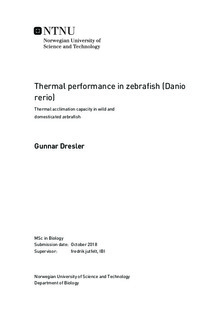Thermal performance in zebrafish (Danio rerio) - Thermal acclimation capacity in wild and domesticated zebrafish
Abstract
In times of imminent threat of climate change, clear evidence of which physiological mechanisms are limiting thermal performance remains scarce. This thesis involved measuring different performances, over a wide range of temperatures, and included a comparison between wild and lab-strain zebrafish (Danio rerio). We hypothesised that thermal optima of different performances will vary like in the multiple performance multiple optima model (MPMO, Clark et al., 2013; Gräns et al., 2014), and that the lab-strain zebrafish, which have been selected to optimise performance at 25-28°C since the 70´s, have reduced the capacity to acclimate to non-optimal temperatures. To test this hypotheses, we performed a pilot study, and two large-scale acclimation experiments on zebrafish, one in summer (n=560) and one in fall (n=600) of 2017. We measured a range of performances including survival, growth rate, acute thermal tolerance (CTmax), and swimming speed. In the pilot and the first acclimation experiment only wild-caught F1 generation zebrafish from India (n=560) were used. Half of the fish used in the second experiment were wild-caught F1 zebrafish (n=300), and the other half were from a lab-strain (AB-WT line, n=300). Both acclimation experiments lasted at least for four weeks to temperatures ranging from 10°C to 36°C/38°C with a difference of 2°C between each, after final temperatures were reached. Mortality differed between all experiments but was especially higher at the upper end of the thermal spectrum. Generally, lab fish displayed higher specific growth rates across temperatures than wild fish. CTmax rose with acclimation temperature in all populations but lab fish showed a lower CTmax at colder acclimation temperatures when compared to the wild population. CTmax was close to equal from temperatures above 26°C. Also, wild fish displayed a better swimming performance at highest temperatures, while the optima of the lab-strain was around 26 to 28°C. Lab-strain zebrafish appear to have maintained their capacity for some performances, e.g. survival and growth, during thermal acclimation, even after decades of adaptation to constant optimal temperatures. Overall the results still suggest a reduced acclimation capacity in lab-strain fish, and also shows varying optima to growth performance in wild zebrafish. Whilst more research is needed to fully investigate the first hypothesis, this thesis adds valuable information on varying optima between growth and swimming speed data, which will differ no matter how metabolic scope would turn out.
